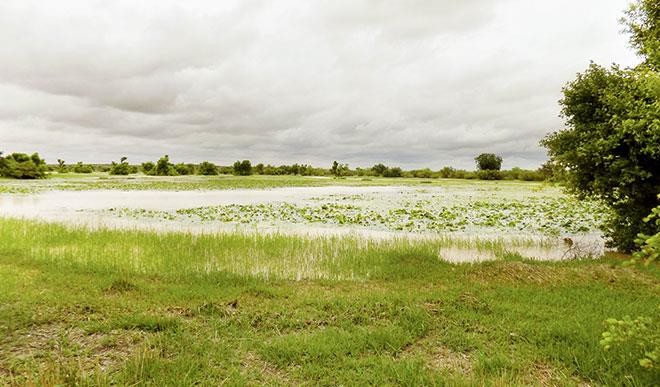
Except for the surrounding millet farms blanketing sections of the sandy landscape, thanks to the rainy season; and the species of shrubs and the mainly stunted desert vegetation, the meandering lake lays bare for whoever visits it for whatever reason.
The landscape and the low and sparse vegetation have over the decades, characterized the fast desert-gnawed belt of the far North, a situation that increasingly places the historical lake under the mercy of ecological forces, slowly gnawing at its prodigious historical significance in the annals of the Western and Central Sudan.
I had chosen to begin with Tafkin Kwatto (Kwatto Lake) in Gudu Local Government Area of Sokoto State, in my series of news features on the identified hinterland lakes of Nigeria, to report on their current state and status in relation to their various significances in history ,and their possible economic potentials for the economic development of the country.
As I walked, on a Tuesday afternoon along a section of the lake’s banks under the still cloudy and fairly cool atmosphere following a heavy rainfall, I reminisced on the images my history and geography teachers in classes six and seven of my early 1970s primary school education, drew of the historical and religious events which took place by this lake over two centuries ago at the commencement of the 19th Century Jihad led by Shehu Uthman Danfodiyo.
Except the lake itself and its name, and the withered historical tree under which the Shehu was said to have been paid homage from the small crowd of his followers, most notably, his younger brother, Abdullahi, his son, Muhammad Bello, his friend, Umarun Mu Alkammu, and his War Commander, Aliyu the son of Jedo, who migrated with him from Degel to Gudu, there is now virtually nothing around Tafkin Kwatto to keep the Jihad history green for modernity and posterity.
The Faru tree, said in the prevailing oral traditions to have spread its branches to provide sufficient shade for the Shehu when he first sat under it on his arrival at Gudu itself, perches on a yet-to-be-submerged piece of land in the lake . During the dry season, I have been told, the lake dries up completely, leaving the tree to go it alone in its battle against ecological forces and other human activities.
The significance of the tree was contained in the brief historical information given during the bicentenary celebration of the Sokoto Caliphate in 2004.
“Under this Faru tree at Gudu is where Shehu’s Jama’a came after Hijra (migration) in 1804. The followers of Shehu were alert and sensitive to the threat of the Gobir forces. As a result they decided to choose a leader who would lead them in their cause. Eventually Shehu was chosen and allegiance (Bay’a) was paid to him….His brother Mallam Abdullahi was the first to pay allegiance, then his son Muhammad Bello, then his friend, Umarun Mu Alkammu and others followed one after the other. This allegiance marks the fundamental landmark in the establishment of what the historians call ‘The Sokoto Caliphate’….
“In their several writings, the Jihad leaders reported this allegiance. Both Abdullahi and Bello reported these events which took place under the (faru) tree in Tazyinul Waraqat and Infaqul Maisur respectively. Also Nana (Nana Asma’u, the daughter of the Shehu) in her poem narrating the movement of Shehu (Wakar gewaye/Habaruje Shehu) reported thus:
“Faru akwaishi ga Majalisa tasa kunjiya.
Nan karkashi nai anka yo cappa tasa.”
Loosely translated:
“Under a Faru tree was where he (Shehu) sat in council.
Under it was where he was paid homage (as the first Commander of the Faithful).
While at Gudu, Shehu Danfodiyo was said to have conducted his lectures and took decisions with his council under the tree.
Tafkin Kwatto has, albeit controvertibly, the highest historical and religious significance in the 19th Century Jihad due its status as the starting point of the Jihad, especially in physical combat terms.
Historically, a spot along its banks formed the first battleground in the Jihad where the Shehu’s small army of the faithful defeated Sarkin Gobir Yunfa’s very large army, to achieve the very first victory in the spreading phenomenon that signposted the eventual carving of a Caliphate spanning sections of the Western and Central Sudan.
The prosperous Jihad, thanks to the June 1804 victory of Tafkin Kwatto forming its decisive starting point, intellectually inspired the execution of two other Jihads in deeper West Africa, and another in the present day Republic of the Sudan in Central Africa.
No one can, however, point at the exact location of that battleground along the banks of the lake.
Religiously, the victory of Tafkin Kwatto signposted what, to a larger extent, still seems an everlasting prosperity for the reformation and purification of Islam from the syncretism, conceptual impurities and pagan practices that had seeped into it over the centuries, and had taken the firmest hold among the authorities religiously charged with the responsibility of ensuring its pristine pure practice.
Moreover, prevailing oral traditions on the jihad say, on his arrival at Gudu, the Shehu declared, “Daga Gudu bamu koma gudun wani Kafiri (this is a Hausa translation of what could have been the declaration in Fulfulde, just in case the Shehu made the declaration”. It means, “From Gudu, never again will we flee from any infidel,” alluding to the migration of the Jama’ah (faithful) from the land of Gobir to Gudu and settling by the Kwatto Lake; and its resolve to, thence, face head-on every hostilities confronting it.
If Uthman Danfodiyo made that historic declaration at his settlement by Tafikin Kwatto, then it holds high historical and religious significance. For, the then small forces of Islamic cum societal reformation and purification, now dared the immense forces of religious syncretism and societal injustices with the former eventually trouncing the latter in the course of the eventually spreading Jihad.
The trouncing took the fashion of a miniature David felling the towering Goliath of Gath.
This declaration: Daga Gudu bamu koma gudun wani Kafiri, is, however, highly controvertible.
“I cannot believe that Shehu Usmanu made this declaration,” a leading authority on the Jihad literature and Chairman of the Zamfara State council of Ulamah, Sheikh Muhammadu Isa Talata-Mafara, said, debunking, “He could not have said it; if he had indeed said it, he would have mentioned it in his literature chronicling the events and activities of the Jihad. Neither have I come across any such declaration attributed to him in the writings of his brother, Abdullahi, his son, Muhammad Bello, and his daughter, Nana Asma’u.”
This position is shared by another authority on the Jihad history, Professor Mukhtar Umar Bunza of the Usmanu Danfodiyo University, who dismissed such oral traditions as: “anyone can say anything baselessly about the Shehu.”
The significance of the Jihadists’ victory at the battle of Tafkin Kwatto was implicit in Tazyinul Waraqat written by Shehu’s younger brother, Mallam Abdullahi:
“Our horses were only 25 while those of Gobirawa, only Allah knew their number. We put our camps close to the stream (the Kwatto lake), we drank and we watered our horses, and then we confronted our enemies, we surprised them. The Gobirawa were not expecting to face a severe assault because they knew we were weaker, and so they brought a lot of materials for comfort. Among these materials for comfort were silk clothes; different types of brocades; several other food items like honey and chips. They were in canopies….eating meat. When we overpowered them, they scattered and left. We took a lot of war booty; among them (the booty) was King Yunfa’s sword…..”
This sword was given to Shehu’s war commander, Aliyu the son of Jedo, whose descendants at Binji hold in custody as the very symbol of the Sarkin Yakin Daular Usmaniyya (War Commander of the Caliphate) and District Headship of Binji to this day.
Those events that conferred the towering status on the Faru tree and the Kwatto Lake took place over 200 years ago.
Now the meandering lake lays bare in the desert terrain, completely bereft of any feature, apart from the withered Faru tree, to tell its visitor that they indeed took place there.
“It collects water during the rainy season, and completely dries up during the dry season,” said Aminu Mohammed, a resident of Balle, the headquarters of Gudu Local Government Area of Sokoto State.
“I totally agree with you that there is the urgent need to preserve the lake and also resuscitate and preserve whatever features around it to preserve the portions of the Jihad history obtainable from there,” Professor Mukhtar Umar Bunza, an authority on the history of the Sokoto Caliphate at Usmanu Danfodiyo University, Sokoto, maintained, recalling, “according to Mallam Abdullahi, the younger brother of Shehu, in his writings, camping around the lake was strategic, the lake was used as war strategy, so it is of utmost significance in the history of the Jihad, which means there is every need to preserve its original features as best as possible to sustain history.”
Professor Bunza recalled further: “There is a similar lake called Tafkin Kanu (Lake of the Heads) in the ruined ancient city of Alkalawa, the capital city of ancient Gobir. It was used by the kings of ancient Gobir as a lake where human executions took place. Criminals sentenced to death were taken and executed there, and their remains would be thrown into it for the crocodiles to feast on. Overtime, it became a large collection of human skulls left by the crocodiles. That is why it is called Tafkin Kanu. It is still there. As researchers, we visited it and saw the need for it to be preserved in spite of the infamy attached to it.”
He maintained: “We are only advisers. Preserving Tafkin Kwatto should be an issue for every relevant authority at the state and federal levels. The lake is an endangered historical artifact. It seems now left at the mercy of the surrounding communities who conduct all sorts of activities in it to the extent that, if care is not taken, overtime we may say, once upon a time there was a lake there.
“Sokoto State government should formulate a policy to dredge the lake and erect structures marking the historical locations around it to preserve its history,” Professor Bunza advised.
Before any such thing is done, Tafkin Kwatto lays bare to the ferocious forces of the times.




